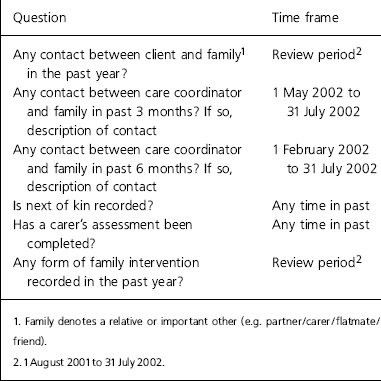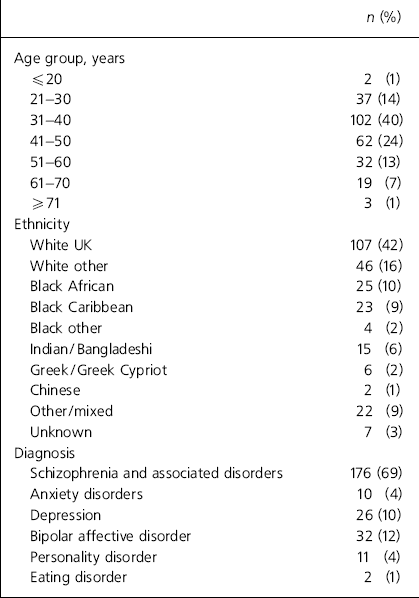Family interventions are one of the best validated psychosocial treatments for schizophrenia (Reference Pharoah, Mari and StreinerPharoah et al, 2002; Reference Pilling, Bebbington and KuipersPilling et al, 2002) and the National Institute for Clinical Excellence (2002) recommends their use. Despite this, they are not routinely included in community treatment plans for people with serious mental illnesses (Reference FaddenFadden, 1997). In addition, standard 6 of the National Service Framework for Mental Health (Department of Health, 1999) recommends the routine assessment of the needs of carers of this group. A number of studies in the UK and the USA have described the difficulties with the implementation of family interventions (Reference FaddenFadden, 1997; Reference Mcfarlane, Mcnary and DixonMcFarlane et al, 2001). Possible reasons include:
-
• lack of staff experience and confidence in family work
-
• cultures that are historically set against family interventions and based on the role of the family in the aetiology and maintenance of schizophrenia
-
• lack of client contact with their family, particularly in urban areas.
Prior to a trust-wide programme to facilitate the uptake of family interventions and carers’ assessments, we carried out a case note review of family contact with clients and staff (care coordinators) of our community mental health teams (CMHTs). We also reviewed the number of family interventions and carers’ assessments offered and taken up prior to the start of the programme. The term ‘family’ was defined as including anybody with whom the client appeared to have an important relationship; for example, relative, family by marriage, carer, partner or friend.
Method
A 10% sample of all clients of all 11 CMHTs from two inner London boroughs were included. These teams were multidisciplinary with integrated management of staff from health and social care backgrounds. They focused on clients with serious mental illnesses and had access to two local family therapy services.
Case-load lists were obtained from each CMHT and every tenth case selected until at least 20 and no more than 25 case files per team had been included. The review covered the period 1 August 2001 to 31 July 2002. All data were collected by one recorder (Y.K.) using a standardised format including demographic details and diagnosis, as shown in Table 1. Ambiguous or missing data were clarified with the care coordinator.
Table 1. Case note review data collected

| Question | Time frame |
|---|---|
| Any contact between client and family1 in the past year? | Review period2 |
| Any contact between care coordinator and family in past 3 months? If so, description of contact | 1 May 2002 to 31 July 2002 |
| Any contact between care coordinator and family in past 6 months? If so, description of contact | 1 February 2002 to 31 July 2002 |
| Is next of kin recorded? | Any time in past |
| Has a carer's assessment been completed? | Any time in past |
| Any form of family intervention recorded in the past year? | Review period2 |
Results
Out of 275 selected case files, 257 were located, representing a 93% response rate. Eighteen files could not be located because of either being transferred between sites, the client being discharged from the CMHT or the file simply being lost. Fifty-eight per cent of clients were male and the mean age was 42 years (s.d.=11.8). The majority had a diagnosis of a severe and enduring mental illness. Demographic and diagnostic details are shown in Table 2. A record of next of kin was found in 83% locatable files (213 out of 257). Seventy per cent of these (181 out of 257) were recorded as a family member, of which 43% (77 out of 181) were the client's mother.
Table 2. Demographic and diagnostic details (n=257)

| n (%) | |
|---|---|
| Age group, years | |
| ≤ 20 | 2 (1) |
| 21-30 | 37 (14) |
| 31-40 | 102 (40) |
| 41-50 | 62 (24) |
| 51-60 | 32 (13) |
| 61-70 | 19 (7) |
| ≥ 71 | 3 (1) |
| Ethnicity | |
| White UK | 107 (42) |
| White other | 46 (16) |
| Black African | 25 (10) |
| Black Caribbean | 23 (9) |
| Black other | 4 (2) |
| Indian/Bangladeshi | 15 (6) |
| Greek/Greek Cypriot | 6 (2) |
| Chinese | 2 (1) |
| Other/mixed | 22 (9) |
| Unknown | 7 (3) |
| Diagnosis | |
| Schizophrenia and associated disorders | 176 (69) |
| Anxiety disorders | 10 (4) |
| Depression | 26 (10) |
| Bipolar affective disorder | 32 (12) |
| Personality disorder | 11 (4) |
| Eating disorder | 2 (1) |
Client contact with family
In 209 out of 257 (81%) case files there was evidence of contact between client and family over the review period, of which 116 out of 209 (55%) was face to face, 10 out of 209 (5%) by telephone and 1 out of 209 (<1%) by letter only. It was not possible to tell what form of contact had taken place in 82 out of 209 case notes (39%). In 13 out of 209 (6%) case files the family did not live in the UK.
Contact between care coordinator and family
In the past 6 months of the review period, 37% (95 out of 257) of the sampled files were found to have evidence of contact between the care coordinator and the client's family, of which 88% (84 out of 95) was with relatives, 6% (6 out of 95) with a friend of the client and 5% (5 out of 95) with a partner. In the past 3 months of the review period this figure was 26% (66 out of 257) and was with a relative in 91% of cases. Table 3 shows the proportions of different types of contact between staff and family in the past 3 and 6 months of the review period.
Table 3. Type and proportion of care coordinator contact with families of clients in preceding 3 and 6 months

| Proportion of each type of contact | Proportion of each type of contact in whole sample where client known to be in contact with family (n = 209) | |||
|---|---|---|---|---|
| Type of contact | Past 6 months n = 95 n (%) | Past 3 months n = 66 n (%) | Past 6 months % | Past 3 months % |
| Direct contact1 | 49 (52) | 28 (41) | 23 | 13 |
| Calls made to family | 55 (58) | 35 (55) | 26 | 17 |
| Calls made by family | 48 (51) | 24 (36) | 23 | 12 |
| Correspondence to family | 28 (30) | 17 (24) | 13 | 8 |
| Correspondence from family | 6 (6) | 4 (6) | 3 | 2 |
Where direct contact was made, this was more than once in 14 out of 49 (29%) and 9 out of 28 (30%) cases in the past 6 and past 3 months of the review period, respectively. Similarly, where telephone calls were made to the family, this occurred more than once in 33 out of 55 instances (60%) in the past 6 months and 16 out of 35 (46%) in the past 3 months of the review period. Where calls were received from the carer this occurred more than once in 21 out of 48 instances (44%) in the past 6 months and 9 out of 24 (38%) in the past 3 months. Where the care coordinator wrote to the family, letters were sent more than once in around one-third of clients (10 out of 28) in the past 6 months and 3 out of 17 (18%) in the past 3 months of the review period. Written correspondence from the carer was received no more than once in any of the reviewed sample in the preceding 6 months.
Carers’ assessments, care programme approach meetings and family interventions
Nine carers’ assessments were located in the reviewed case files, representing 4% of clients known to be in contact with their family (n = 209). In two further files an offer of assessment and subsequent refusal on the part of the family was recorded. An intention to offer an assessment without formal refusal was noted in four additional files. Thus, carer's assessments were noted in 15 out of 209 files (7%) in total.
A family member was present at a care programme approach (CPA) meeting at least once in 38 out of 209 of instances (18%) during the 12-month review period. Specific family work of any kind was recorded in 6% of case files (12 out of 209) of clients known to be in contact with their family. This included formal family therapy, psychoeducation (‘family matters’) workshops, carers’ and young carers’ projects and counselling from non-statutory services, the general practitioner or care coordinator.
Discussion
Our survey relied on case note data and is therefore subject to recorder bias. However, we suspect that any under-recording would be more likely in the contacts between clients and their relatives rather than between care coordinators and the clients’ relatives. Also, this survey was based in a single mental health and social care trust in an inner city area and results may not be easily generalised to dissimilar settings.
Overall, therefore, this case note review has confirmed a very low prevalence of family interventions for people with schizophrenia under the care of CMHTs, which is in marked contrast to the high level of contact we identified between clients and their families. The majority of contact between staff and family is informal, with very few structured interventions taking place such as carers’ assessments or attendance at care programming meetings. This is in keeping with the findings of Dixon et al (Reference Dixon, Luckstead and Stewart2000) who surveyed a mental health service for people with serious mental illnesses in Baltimore, USA and found that in around 60% of cases, mental health professionals had made at least one contact with their clients’ family over the preceding year, usually by telephone. Our findings suggest a less encouraging picture than that shown by a recent large national postal survey of mental health service users and carers carried out by Rethink (Reference CorryCorry, 2003) who reported that relatives of people with mental health problems were in contact with the professionals involved in the care of their family member in 49% of cases but 32% were unaware of the meaning of the CPA, 53% were unaware of the details of their relative's care plan and only 24% felt that professionals valued their input.
Our findings suggest that we have an opportunity to build on the informal links that care coordinators make with the families of their clients to assist and encourage family support in the care of their relative. This might be done through a variety of interventions focused according to the family's needs and ranging from regular telephone support through to individual family meetings, family support groups, multifamily groups and family therapy. It is expected that this would lead to increased uptake of such interventions as well as increased use of carers’ assessments and involvement of the family in CPA meetings.
Declaration of interest
S.P. is in receipt of funding from the Department of Health, the National Institute for Clinical Excellence and the Alcohol Education Research Council.
Acknowledgements
We acknowledge the help and cooperation of all CMHTs across Camden and Islington Mental Health and Social Care Trust who facilitated the smooth running of the project, and the trust for supporting our work throughout this time.






eLetters
No eLetters have been published for this article.